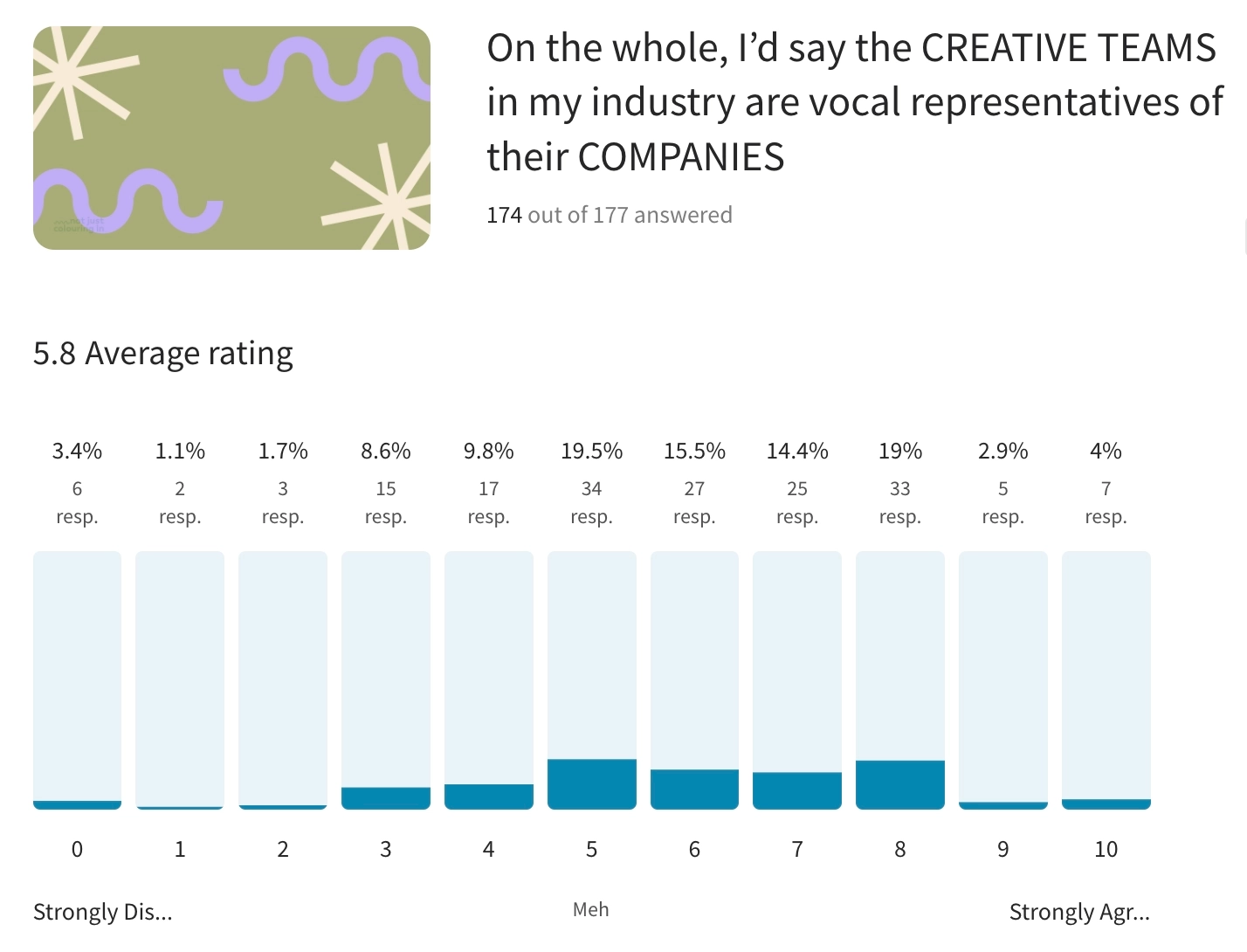NJCI Insights | Creative teams as vocal representatives

TL:DR The NJCI survey highlights that creative teams need to be more vocal about their contributions to enhance their visibility and impact within their companies and the industry to be recognised as strategic, revenue-generating centres.""

Creative teams need to make more noise. During our time in the industry we’ve worked with loads of different types of brilliant creatives and we have noticed a conspicuous absence of them in the spotlight. This doesn’t mean they’re not social, engaging people. But, attending networking events, posting daily on social media, prolific employee advocacy and generally shouting about what they do, aren’t common traits. Companies also don’t expect this from their creatives, they’re far too busy grafting!
This brings us to the next question in the NJCI survey, we asked, ‘On the whole, I’d say the creative teams in my industry are vocal representatives of their companies.’ The average score of 5.8 out of 10 suggests a lukewarm sentiment from the creative professionals surveyed. This ambivalence reveals a significant opportunity for creative teams and their companies to better align and elevate their profiles and work both internally and externally. In this article we’ll look at the potential challenges creative teams face in becoming vocal representatives of their companies and why it’s important to overcome these obstacles.
The Role of Creative Teams in the Licensing Industry
Creative teams in the licensing industry are sometimes perceived as the ‘colouring-in department,’ responsible for making great work without contributing to the strategic vision of the company or receiving much recognition from the industry. This stereotype is not only unfair but also detrimental to the sector as a whole. You’ve told us you want creative departments to be seen as the revenue generating centres they are and not to be treated as a cost to be squeezed. A key step in this mission is advocating for the work your company produces. The licensing industry is built on creativity and it’s time for that to be at the fore-front, just like in fashion or movies. When teams are vocal representatives of their company's work, they are promoting their own abilities and creativity along with their employers.
Positioning the Creative Department as a Profit Center
Creative leads need to be as prominent and vocal as their commercial counterparts, demonstrating the tangible value their work brings to the table. By doing so, they not only elevate their own status but also inspire other designers in the industry to advocate for themselves more effectively.
Why Being Vocal Matters
Visibility of Contributions
One reason creative teams might not be seen as vocal representatives is that their contributions often go unnoticed or unrecognised. It’s crucial for creative teams to actively showcase their work and its impact on the company’s success. This could include internal presentations, case studies, or regular updates in company-wide meetings. Externally, work submitted for awards will raise recognition, just be sure the creatives are the ones on the stage accepting the award 👀
Building Stronger Connections
Creative teams can bridge the gap between different departments, fostering a more cohesive and collaborative company culture. By sharing insights and successes, they can help other teams understand the value of their work, leading to more integrated and effective business strategies. Read our blog post on how you can improve your commercial colleagues' understanding of your work here.
Enhancing Company and Client Image
Externally, creative teams are the custodians of a company’s and clients' images. Their work influences how the company and its clients are perceived by customers, partners, and the general public. Being vocal representatives means actively engaging with these audiences through social media, working with your marketing department (if you have one), and attending industry events.
Overcoming Barriers
Navigating NDAs
Non-disclosure agreements (NDAs) can limit what creatives can share about their work. However, they can still discuss general processes, methodologies, and the broader impact of their work without revealing sensitive details. By focusing on the "how" rather than the "what," creative leads can still be vocal and influential. At Skew we have integrated case study discussions into client onboarding to align expectations and avoid those awkward conversations further down the road.
Encouraging Designer Advocacy
Having vocal creative leads can inspire other designers to advocate for themselves. When industry figures from the creative side share their successes and challenges, it provides a powerful example for others to follow, fostering a culture of self-advocacy and recognition within the industry.
Recommendations for Creative Teams
Be Proactive
If no one else is promoting the work of your department, it’s up to you to take the initiative. Create a portfolio of your team’s achievements and share it widely within your organisation. Regularly update your colleagues on current projects and past projects outcomes.
Highlight Your Impact
Don’t just show what you’ve done; explain why it matters. Connect your work to the company’s and client's broader goals and objectives. Find ways to prove your work's worth. This may be difficult at first but building a strong relationship with the client and asking about outcomes of your collaboration will help you establish ROI.
Seek Feedback and Collaboration
Invite feedback from other departments to ensure your work aligns with their needs and expectations. Collaboration can lead to more innovative and effective solutions, demonstrating the strategic value of the creative team.
Recommendations for Companies
Recognise and Reward
Companies need to actively recognise and reward the contributions of their creative teams. This could be through formal recognition programs, bonuses, or opportunities for professional development. Also putting them on stage at the awards along with their commercial colleagues!
Invest in Professional Development
Provide opportunities for creative teams to develop their skills and stay updated with industry trends. This not only benefits the individual team members but also ensures that the company remains at the forefront of innovation.
- Creative leads: You are not just colouring in if … you’re making some noise! Working with others in the business and wider industry to highlight the wonderful creative work you and your team are doing.
- Creative professionals: You are not just colouring in if … putting yourself out there and taking what you deserve. Don’t wait for people to ask, tell them!
By becoming more vocal representatives of their organisations, creative teams can significantly enhance their visibility, impact, and the overall success of the company as well as their own work. Proactive communication, showcasing impact, and fostering collaboration are key steps that can transform the perception and reality of the role creative teams play in their companies. It’s time to move beyond the just ‘colouring-in’ stereotype and recognise the strategic importance of creativity in the licensing industry.
Want to be part of NJCI?
NJCI is here to change the conversation. You’ve told us you want creative departments to be seen not just as a cost to manage, but as powerful profit generators. The 2024 NJCI report is the first step in making that vision a reality.
In this blog post, we outlined how important it is for creatives to become vocal representatives within the brand licensing world. By understanding their contributions and showcasing their value, we can push innovation and drive industry success. Our mission is to help creative teams secure a stronger voice and a seat at the table to influence the industry’s direction.
Sign up for NJCI today and get your copy of the report here. It’s packed with insights from creatives in licensing and includes Skew’s actionable recommendations for the future.





